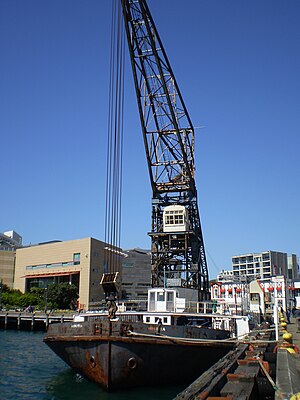Hikitia
 Hikitia at the Taranaki Street wharf
| |
| History | |
|---|---|
| Name | Hikitia |
| Owner | Maritime Heritage Trust of Wellington |
| Port of registry | Wellington |
| Builder | Fleming & Ferguson, Paisley, Scotland[1] |
| Yard number | 486[1] |
| Launched | 15 April 1926[1] |
| Maiden voyage | 29 September 1926[citation needed] |
| Identification | IMO number: 5150393 |
| Status | Operational |
| General characteristics | |
| Tonnage | 746 GRT[1] |
| Displacement | 926 tonnes |
| Length | 160.1 ft (48.8 m)[1] |
| Beam | 52.3 ft (15.9 m)[1] |
| Depth | 11.35 ft (3.5 m)[citation needed] |
| Installed power | steam engines originally fed by coal-fired Scotch boilers, later replaced in 1963 by oil-fired boilers and then by small modern package boilers.[citation needed] |
| Propulsion | twin screw[1] |
| Speed | about 10 kn (18.5 km/h)[citation needed] |
Hikitia is a working self-propelled floating steam crane in Wellington, New Zealand. She is thought to be the only working steam crane of her type in the world. She is also the sister ship to the Rapaki, formerly of the Port of Lyttelton, which is now at the New Zealand Maritime Museum.
Engines
Twin screws are driven by surface-condensing direct-drive compound engines which were supplied with steam by a coal-fired Scotch boiler with two furnaces. A similar but oil-fired boiler replaced the original boiler in 1963. In 1980 this was also removed and the present two locally made small modern package boilers were installed.[2] These new boilers produce less steam than the original ones.[citation needed]
Crane
The hull of the vessel was built by Fleming & Ferguson and the crane was built by Sir William Arrol & Co. of Glasgow. The crane alone weighs 310 tonnes, and was built to lift 80 tonnes. However, while dismantling the wreck of TEV Wahine it is thought that she lifted 140 tonnes.[3] In 2004 she lifted 100 tonnes to maintain her lifting licence of 80 tonnes. Her most recent lift was a 20 tonne ice plant in Lyttelton.[citation needed]
Refurbishment
Hikitia travelled to Lyttelton in June 2009 for hull, tail shaft and various other underwater repairs.[4] While in Lyttelton, she moved an ice plant between wharves to repay part of her refurbishment at the port's dry dock. The venture south was the ship's first time out of Wellington since 1926.[citation needed]
References
- ^ a b c d e f g Cameron, Stuart; Allen, Bruce; Robinson, George. "Hikitia". Clyde-built Database. Archived from the original on 27 June 2007. Retrieved 23 May 2011.
{{cite web}}: CS1 maint: unfit URL (link) - ^ Bennett, Geoff. "HIKITIA - A BRIEF HISTORY". Maritime Archaeological Association of New Zealand. Archived from the original on 25 May 2010. Retrieved 5 September 2009.
- ^ Lambourne, Jason. "Crane is part of Wellington's heritage". NZ Professional Skipper Magazine. Archived from the original on 14 October 2008. Retrieved 16 July 2009.
- ^ Hampton, Jeff. "Hikitia: rare steam crane comes out of retirement". 3 News NZ. Retrieved 20 October 2009.
External links
- Hikitia Heavy Lift Ltd
- Crane Event from Heritage New Zealand, Autumn 2005
- Maritime Archaeological Association of New Zealand
- Official website
